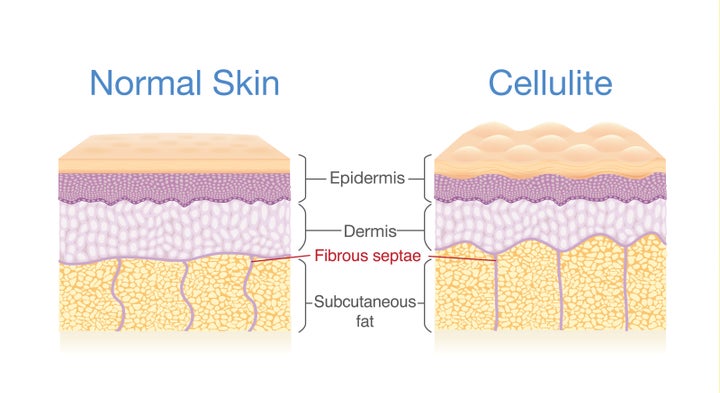For many, cellulite is a dreaded part of growing up, with its cottage cheese-like texture dotting our thighs as early as our teen years. But have you ever noticed that it’s much more of an issue for women than men?
We asked some of the country’s top doctors why so many more women than men have cellulite. Although several factors influence whether or not someone develops cellulite, it comes down to key differences in the way men’s and women’s bodies are structured under our skin.
What is cellulite, anyway?
Contrary to popular perception, cellulite isn’t fat itself — rather, it’s skin that “appears dimpled or uneven,” explains Dr. Andy Chien, a dermatologist at Kaiser Permanente in Seattle, Washington. It is most often seen on the “thighs, hips and buttocks of women post-puberty,” he said.
Often, cellulite looks like an “orange peel,” said Dr. Jennie Stanford, an obesity medicine physician and medical contributor for Drugwatch. It is usually seen “on the thighs, buttocks and abdomen” of women, she explained. It’s “a common condition that can be seen in people of all body types,” said Dr. Joel Kopelman, a plastic surgeon with Kopelman Aesthetic Surgery.
What causes cellulite?
How cellulite forms is “complex and multifactorial,” Stanford said.
When fat cells beneath the skin grow, they “expand and push against the connective tissue” just below the skin’s surface, Chien explained.
When this happens, the connective tissue beneath the skin “contracts and traps fat, pulling down on the skin while the fat pushes up,” Kopleman explained. This “disrupts the smooth appearance of the skin and leads to a dimpled effect,” Chien added.
Several factors can cause cellulite to form, and it’s not always clear what causes cellulite in each individual. Stanford says, “Genetic predisposition plays a crucial role, as some genes influence fat distribution and connective tissue characteristics.”

Lifestyle factors also play a role. A sedentary lifestyle or a diet high in processed foods can lead to weight gain, which causes fat to accumulate, Stanford said. Moreover, “lack of exercise often causes decreased muscle tone,” which can lead to a “worsening cellulite appearance,” Chien added. Hormonal changes can also cause cellulite to form.
Why don’t most men have cellulite?
Both women and men can develop cellulite, Kopelman said. However, “it’s overwhelmingly more common in women, largely because of the way their bodies are built,” he explained. There are four primary reasons why this is the case.
First, connective tissue under the skin is formed differently in men and women. “In women, these connective tissues are arranged vertically,” like bands, “which allows the fat to push up more easily and create that lumpy appearance,” Kopelman explained. “Men, on the other hand, have a more crisscrossed structure, which tends to hold the fat in place better.” Men with the same body type as women are far less likely to develop cellulite because of differences in how connective tissue holds the fat. That’s why even “very fit” women may have cellulite while heavier men may not have any, he said.
Second, “women have more subcutaneous fat,” Kopelman said. He explains that subcutaneous fat tends to form “in the thighs and hips, where cellulite is more noticeable.”
Third, he explained that “hormonal changes, particularly related to estrogen, also play a huge role” in how cellulite develops. Estrogen, sometimes called the “female hormone,” is essential for women’s health. Because estrogen “influences fat distribution, collagen production, and skin elasticity, it can have a direct effect on how fat is stored and how the skin’s connective tissue behaves,” Kopelman explained.
Many women notice an increase in cellulite when estrogen levels drop during menopause. When this happens, “collagen production decreases, fat cells enlarge, and those fibrous bands under the skin can start to pull down,” causing more cellulite, Kopelman said. However, it’s a double whammy ― increases in estrogen can also cause cellulite. “When estrogen levels rise, like in puberty or pregnancy, fat is more likely to accumulate in areas like the hips, thighs and buttocks, which makes cellulite more noticeable in those regions. It’s really about the way estrogen impacts both fat storage and skin structure,” Kopelman said.
Fourth, women have thinner skin than men. Stanford explained that women’s skin tends to be thinner on their “buttocks and thighs, where cellulite is most likely to appear.” Men tend to have thicker skin, which makes cellulite less noticeable.
Does cellulite indicate a medical issue?
Cellulite “does not necessarily reflect any underlying medical condition” and should “be viewed as a natural result of aging in most people,” Chien said. “As many as 80% to 90% of women will be affected by this condition,” he explained.
While treatments to reduce the appearance of cellulite are available, Kopleman said they’re solely for aesthetic reasons. According to Kopleman, some creams and “cosmetic procedures like laser therapy, cryotherapy and radiofrequency treatments may also help reduce the appearance of cellulite.” He said that lifestyle changes, such as “exercise, a healthy diet, and maintaining a healthy weight,” can also help,
However, Kopelman cautions that there are “risks to some of these treatments.” Because cellulite is not harmful, “these potential risks should be weighed carefully with the possible benefits,” he said. Kopelman emphasized that not all available treatments will deliver the desired results, either. He advises anyone considering treating their cellulite to speak with their primary care physician or dermatologist first.
“Embracing body positivity,” Kopelman said, “and focusing on overall health and well-being is a great way to accept cellulite as part of the normal human experience.”

